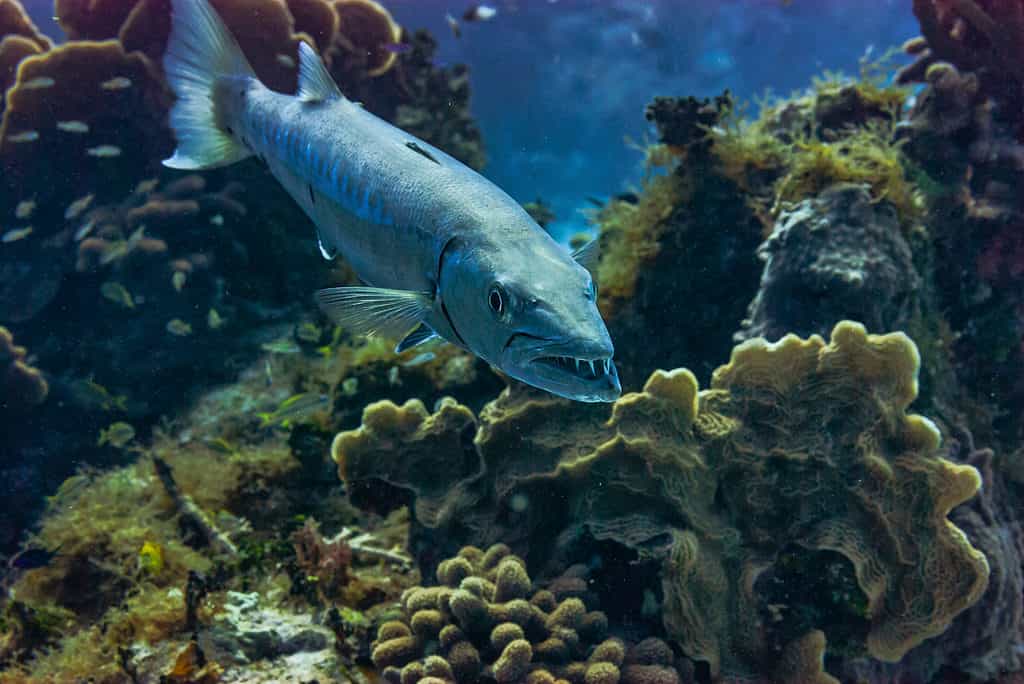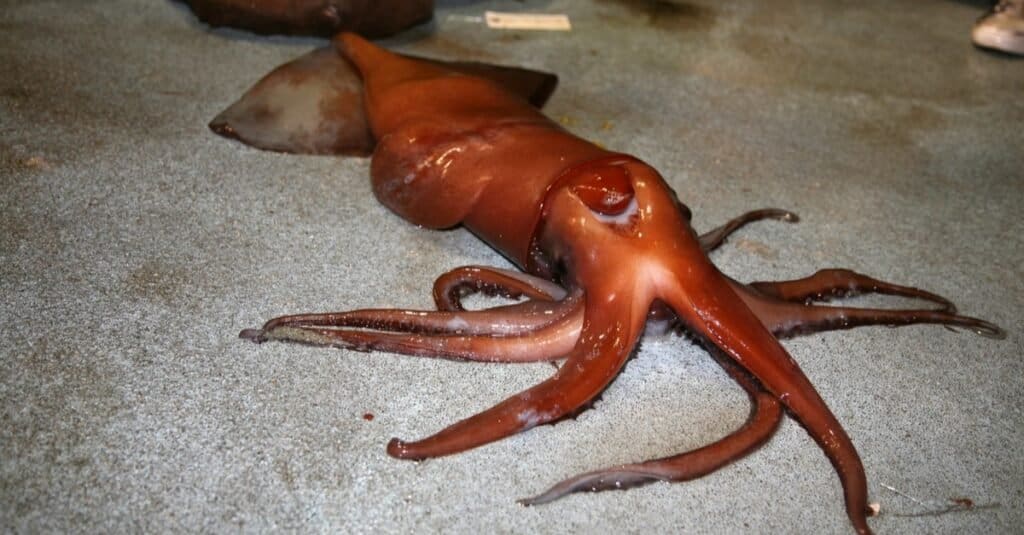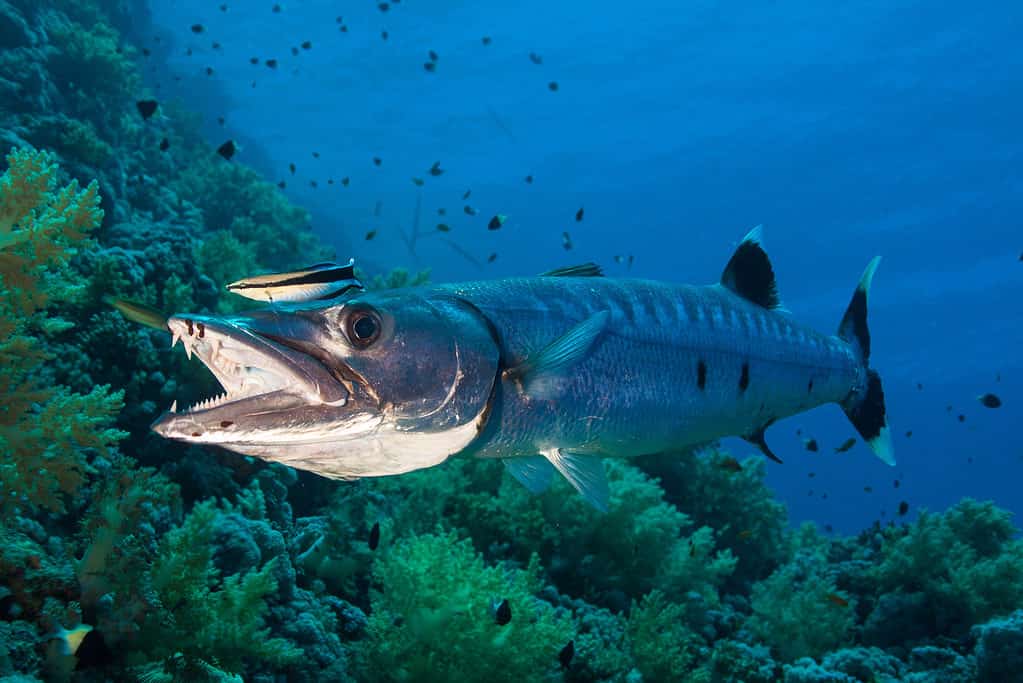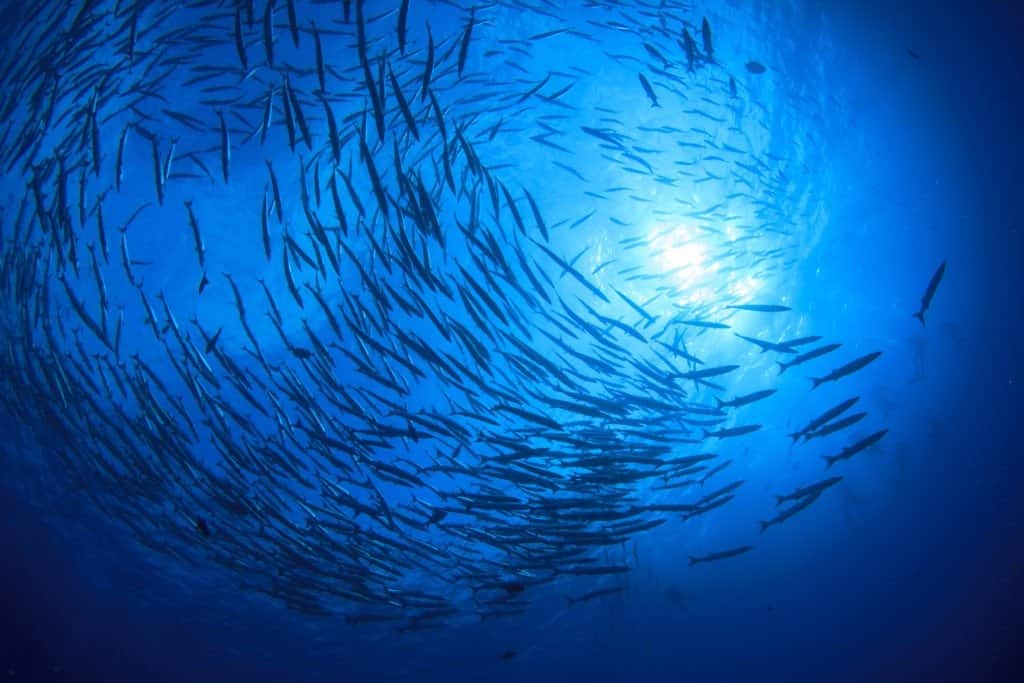Introduction
Giant squid and barracudas are two of the most fearsome marine animals swimming through the earth’s oceans and seas. Both creatures have razor-sharp teeth and a menacing appearance. While these animals are rarely a threat to humans, they are fierce attackers of prey. When confronted with a predator, the <a class="wpil_keyword_link" href="https://a-z-animals.com/animals/barracuda/" title="barracuda and giant squid will use unique techniques to evade capture. However, one of these marine creatures is much stronger and more formidable than the other. Discover which animal would win in a fight and find out how they defend themselves.

Check out the <a class=”wpil_keyword_link” href=”https://a-z-animals.com/animals/barracuda/” title=”
barracuda
‘s razor-sharp teeth!
©Focused Adventures/Shutterstock.com
Background on the Giant Squid
The term “giant squad” encompasses many species of large cephalopods that are found at great depths in the oceans or seas. Giant squid prefer a temperate or subtropical climate, which can describe a wide range of water temperatures. The giant squid resides well below the surface at great depths. Researchers in Japan first captured footage of the giant squid at a depth of approximately 2,950 feet.
Giant Squid Appearance
Despite its formidable name, the giant squid shares many similarities with other squid species of smaller sizes. Namely, this animal has a head, a mantle, and other parts that align with its cephalopod classification. Some examples of features of the giant squid are eight arms and two fins connected to either side of the mantle. Like the tentacles of other squids or of the octopus, the tentacles of the giant squid have suction cups, which allow them to seize their prey.
The giant squid also has extremely large eyes with a maximum diameter of 10.6 inches. For comparison, the giant squid’s eyes are roughly the size of a dinner plate, perhaps even rivaling the size of a human head. Supposedly, the large eyes of the giant squid aid it in deciphering large objects. In addition, giant squid eyes are said to have binocular vision.
How “Giant” is the Giant Squid?
Many consider the giant squid to be the largest invertebrate on Earth. However, others say that the colossal squid is the largest invertebrate, making the giant squid rank second in invertebrate size. What is the reason for this debate? The size of the giant squid and the colossal squid are relatively similar. In fact, some experts believe that the giant squid maintains a greater mass than the colossal squid but is smaller in length on average.
Few reports indicate a maximum length of the giant squid to measure over 59 feet. However, most scientists claim that 43 feet is the giant squid’s maximum length. On the other hand, scientists have determined that the giant squid could measure up to 66 feet in length in the future. Therefore, the exact range of a giant squid’s length is unknown, leaving the question of which squid is larger up for debate.

Giant squid can measure up to 43 feet in length!
©mikeledray/Shutterstock.com
Giant Squid Classification
Furthermore, many experts argue over the taxonomy of the giant squid. Some believe that giant squids belong to several subspecies while others claim the giant squid falls under one species of invertebrate. Despite arguments over the creature’s size and classification, the giant squid has left considerable influences on the scientific and literary world. The giant squid often appears as a sea monster in literature and in historical accounts.
Dangers of Giant Squid
Most squid species are considered both predator and prey, being in the middle of the food chain. However, giant squid are less susceptible to predation due to their habitat. That is, giant squid prefer to live in great depths, where little marine life and few predators reside. The main predators of giant squid are sperm whales and a few shark species. However, giant squid can conceal themselves from predators through camouflage.
If a giant squid meets a predator, it will attempt to flee. The giant squid releases ink in the water to cloud the vision of a predator. In addition, ink irritates the eyes of a predator, and it will upset their sense of taste and smell. The distraction will allow the giant squid some time to escape before the predator follows them. If a giant squid cannot flee the predator before an attack, though, the squid might engage in a physical fight. This species will either bite a predator with its beak, located between its arms, or wrap its tentacles around a predator.
Giant Squid and Prey
Prey of giant squid are other cephalopods, fish, and crustaceans. When giant squid attack prey, they release two feeding tentacles. Suction cups on the tentacles have very small teeth, which attach to the prey. One interesting fact about the feeding tentacles of the giant squid is that they are much longer, perhaps even double, the length of the squid itself. When the toothed suction cups attach to desirable prey, the squid’s tentacles will drag the victim toward their beak. When the prey meets the beak, it will be sliced up and transferred into the mouth of the giant squid. From there, the “tongue,” called the radula, contains little rows of teeth that further devour the prey.
While the giant squid’s manner of attacking prey seems formidable, the species isn’t extremely strong. In fact, a smaller species of squid, the Humboldt squid, is considered much stronger than the giant squid, according to its ratio of strength and size. In addition, the giant squid is highly aggressive, but it is not as aggressive as the Humboldt squid. Both squid species, though, are strong and aggressive enough to kill humans.
Is Giant Squid Dangerous to Humans?
Some giant squid have attacked human divers that have explored the ocean’s depths. However, giant squid will only attack when they or their habitat seems to be in danger of human interference. Since the giant squid resides in extreme depths, humans rarely encounter these creatures. Thus, the likelihood of a human being attacked by a giant squid is low.

The beak of a giant squid slices up prey.
©The Trustees of the Natural History Museum, London / CC BY 4.0 – License
Background on the Barracuda
Barracuda describes approximately 20 fish species within the family Sphyraenidae. Like the giant squid, barracudas prefer temperate or tropical waters. The habitat of barracudas includes reefs, mangroves, and seagrasses. Some barracudas also swim in open waters, and they prefer shallow water. The greatest depth that a barracuda might be found measures 325 feet. By comparison, the giant squid lives at depths greater than 2,950 feet. Therefore, it is highly unlikely that a barracuda and a giant squid would ever meet, let alone engage in a fight.
Some predators of the barracuda are sharks, dolphins, goliath grouper, and tuna. However, these predators encounter difficulty in catching and feeding on barracudas, as the barracuda is extremely fast. In fact, barracudas can swim at speeds up to 35 miles per hour. However, the barracuda is not incredibly strong; it may evade a predator, but it is unlikely the barracuda could put up a good fight against a predator much larger than itself. Like the giant squid, this species protects itself through camouflage. Barracudas can blend into the sand and rocks found on the ocean floor.
Barracuda Appearance
The barracuda is very slim, and its lower jaw sticks out from below its upper jaw. In addition, the jaws of a barracuda contain a plentiful number of large teeth, which are very sharp. Most barracudas measure between four and six feet in length. In addition, barracudas may weigh up to 100 pounds.
The coloration of the barracuda usually ranges from a washed-out brown to a gray-blue color. The underside of the barracuda is white. Some barracuda species have different coloration and patterns than others. For instance, the great barracuda has black spots, which are not visible on many other species.
Most barracudas, though, have numerous dark bars across their bodies. As juvenile barracudas grow, though, their patterns may begin to fade. Juveniles quickly learn how to camouflage themselves into their surroundings to avoid predation. In doing this, juveniles must change their coloration and reduce visible patterns. This action leads to a gradual fading of patterns visible on the body.

Barracudas have a brownish or gray-blue coloration.
©Itstvan Kovacs/Shutterstock.com
Dangers of Barracudas
Barracudas rely on their eyesight to best find and capture prey. When prey is discovered, a school of barracudas works together to trap prey by swimming in circles around it. When this fish attacks prey, it snatches it in its powerful jaws. Barracuda teeth in the top jaw are perfectly aligned with those in the bottom jaw. When a barracuda closes its mouth on prey, the teeth fit into place, barring the prey from any chance of escape. Furthermore, this fish may swallow prey whole if it is small but will likely slice the prey into smaller pieces with its teeth if the prey is large.
Are Barracudas Dangerous to Humans?
Barracudas are considered dangerous to humans and other animals, being highly aggressive and formidable. The prey of barracudas includes other kinds of fish, such as mullets and anchovies. Many people enjoy fishing for barracudas, and some species are incorporated into recipes for food. However, those that eat barracudas should take caution because these fish are susceptible to becoming poisoned in various regions.
For example, many instances of ciguatera poisoning have occurred in great barracuda populations. Marine dinoflagellates connected to algae produce ciguatoxins, which are poisonous to fish. If these algae and the connected marine dinoflagellates are accidentally consumed by barracudas, the fish will become poisoned. This poison builds up in the flesh of the fish. If humans consume this flesh, they will also become poisoned. Ciguatera poisoning in humans results in several symptoms, including gastrointestinal diseases and body fatigue.
Overall, barracudas are highly aggressive, violent, and quick, allowing them to fight fast and do some serious damage. While the species is a threat to humans, barracudas rarely attack them. Barracudas often attack humans when they feel threatened or when they notice shiny jewelry. In most cases, barracudas mistake shiny jewelry for the scales of a fish, which they want to attack for food.

Barracudas encircle prey to capture it.
©Rich Carey/Shutterstock.com
Giant Squid vs. Barracuda: Which Animal Would Win in a Fight?
In an epic battle between a giant squid and a barracuda, the giant squid would come out victorious. While the two creatures live at different depths and are unlikely to meet, there are several reasons why a giant squid would win if a fight ensued. First, the giant squid is significantly larger than the barracuda. In addition, the squid is much stronger than the fish. However, the barracuda might be able to quickly flee a giant squid attack.
In the case that the barracuda is unable to swim away, though, the giant squid’s powerful tentacles could wrap around the barracuda, trapping it. Then, the giant squid would likely use its beak to ferociously bite the fish. While the barracuda might bite back, the giant squid could easily blind the barracuda with its ink. Since the barracuda relies heavily on eyesight to attack prey and defend itself, the fish would be left with no protection against the massive, fearsome squid. Therefore, the barracuda would lose the battle, and the giant squid would be deemed the winner.
The photo featured at the top of this post is ©
Thank you for reading! Have some feedback for us? Contact the AZ Animals editorial team.






